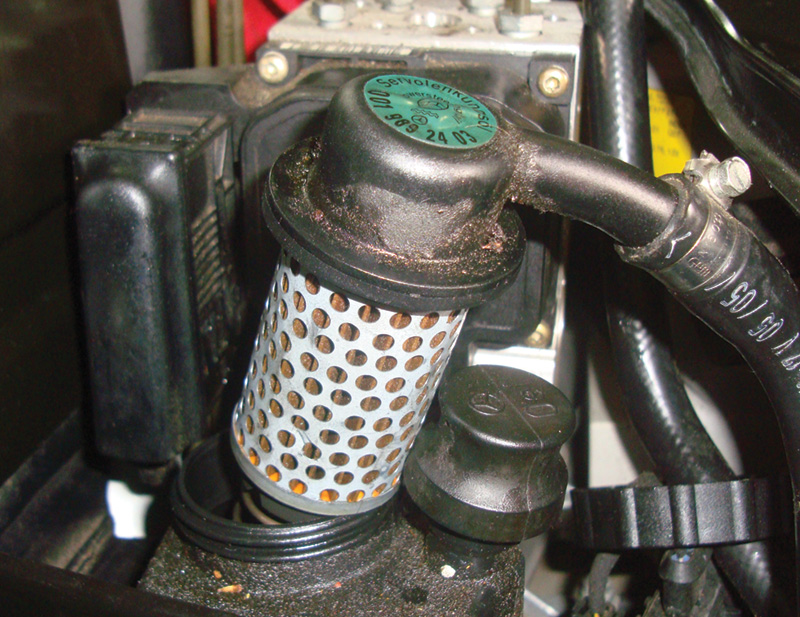When opening up one of these high-pressure systems there are some special procedures you must observe.
 As with any computer-controlled electro-mechanical system, there are two sides to the ABC story: the electrical/electronic side and the mechanical side. The former can be identified, monitored, and controlled with an SDS (Star Diagnostic System), available for purchase from Mercedes-Benz USA. This scan tool is capable of reading the control unit information including the software version level, which can be important in determining if an update needs to be performed to fix a problem. Of course, it can also read diagnostic trouble codes (DTCs), but it goes way beyond that by offering a guided fault-finding flowchart when you select the code you want to troubleshoot. In addition, you can read specific data in real time as the vehicle is being operated. Finally, it is a requirement when replacing control units that may need to be programmed or initialized before being put into service.
As with any computer-controlled electro-mechanical system, there are two sides to the ABC story: the electrical/electronic side and the mechanical side. The former can be identified, monitored, and controlled with an SDS (Star Diagnostic System), available for purchase from Mercedes-Benz USA. This scan tool is capable of reading the control unit information including the software version level, which can be important in determining if an update needs to be performed to fix a problem. Of course, it can also read diagnostic trouble codes (DTCs), but it goes way beyond that by offering a guided fault-finding flowchart when you select the code you want to troubleshoot. In addition, you can read specific data in real time as the vehicle is being operated. Finally, it is a requirement when replacing control units that may need to be programmed or initialized before being put into service.
For example, the code C1531-008 means that despite the fact that the right rear valve has been commanded closed, the height value has changed while the vehicle was shut off. This points to either an external or internal leak in the right rear strut assembly or valve. By clicking F3, you can access a flow chart that will take you through a step-by-step diagnostic procedure to nail down the trouble.
 Before you can diagnose such a problem, however, the basics of the system must be in proper order. There needs to be the correct amount of fluid so that the ABC pump can operate at the right pressure, and the pump itself needs to be capable of generating enough pressure to raise the vehicle.
Before you can diagnose such a problem, however, the basics of the system must be in proper order. There needs to be the correct amount of fluid so that the ABC pump can operate at the right pressure, and the pump itself needs to be capable of generating enough pressure to raise the vehicle.
As mentioned in the main article, ABC uses the same reservoir and pump as the power steering system. The fluid level should be checked while the engine is running and the system is operational. The dipstick has two levels marked on it. The higher of the two is for when the vehicle is at the lowest height setting, and the lower one is for when the vehicle is at the highest height setting. Obviously, at the lowest height setting the volume in the struts is smaller and therefore more fluid will return to the reservoir, and vice versa. Keep this in mind when checking the level. Also, use only fresh new hydraulic fluid to refill after draining.
A filter is mounted in the reservoir, and you should replace it whenever you open the system. This is an absolute must when you have had to replace the hydraulic pump. The ABC system is self-bleeding, so you should not have to open any valves to let air out of the hydraulic circuits. After draining and refilling, however, you should let the vehicle sit for as long as possible to let any air escape that may have entered the system while it was open. Using your SDS to put the system into “Rodeo†mode will not only check the system for self-diagnostic codes, but will also open all of the valves to raise and lower the vehicle. This is an excellent way to expel any air that may be trapped in the system.
Finally, Mercedes-Benz strictly specifies CHF-11S fluid for its hydraulic systems. This is a green-tinted synthetic fluid far superior to older, non-synthetics typically used in the past for power steering. It’s foolish to use anything but the right stuff.Â
| Vehicle | 230.475 | Control unit | ABC | |
| Fault Codes | ||||
| Code | Text | No. | Status | |
|
C1531-008 |
Right rear suspension strut moves although locking valve is closed. |
0 |
STORED |
|
|
This kind of SDS DTC explanation makes it easier to zero in on a problem. |
||||
Â






0 Comments